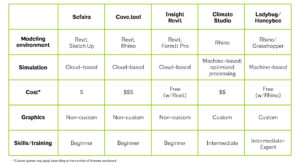
Every year, the built environment produces around 40% of global emissions. But unlike most industries, apart from feedback by communities and civic leaders, the building profession has only a handful of stakeholders—owner, architect, engineer, contractor—who influence how projects are created. What does this mean? Architects, perhaps more than members of any other profession in the world, can directly influence CO2 emissions through their designs. “This is a huge chance to create change,” says Jeremy Knoll, AIA, an associate principal at BNIM in Kansas City, Missouri. “Compared with, say, the auto industry, in which multiple job titles influence every decision, architects can truly be a voice in the room to champion the reversal of project emissions. Ultimately, this is on us.”
With federal standards nonexistent and regional codes varying, and often of little substance, designing projects in ways that benefit the environment can be a challenge. So in 2009, The American Institute of Architects created the AIA 2030 Commitment to give designers and builders a set of standards and goals for reducing emissions. Supporting the aims of the 2030 Challenge—to make all new buildings and major renovations carbon-neutral by the end of this decade—the 2030 Commitment gives architects access to practical tools, including the Design Data Exchange (DDx), an online resource for tracking progress against industry averages. Architects use 2030 Commitment resources including the confidential, user-friendly DDx data to make a real difference. “We need to create net-zero buildings, and the 2030 Commitment is key to helping us get there,” says Yukari Kubo, AIA, the codirector of sustainable practice at YGH Architects in Portland. “I use the commitment to create guidelines on every project. Also, being able to present a national standard really helps us make the case for greener design with our project teams and clients—it establishes a common dialogue and goals.”
Tips on how to succeed with the 2030 Commitment
The AIA 2030 Commitment and DDx help your firm go carbon-neutral by 2030. Here are some tips for using these resources for every project.
 Embed the 2030 targets within your firm’s goals starting with net zero: Any evaluation of a project should make it clear that performance is a component of the criteria by which design excellence will be measured. A commitment to strive for net zero and use 2030 targets helps promote high performance. Consider highlighting predicted energy use intensity (pEUI) while celebrating project design award recipients. A firm’s leadership should instill in its culture the ethos that outstanding design can’t be achieved without outstanding environmental performance.
Embed the 2030 targets within your firm’s goals starting with net zero: Any evaluation of a project should make it clear that performance is a component of the criteria by which design excellence will be measured. A commitment to strive for net zero and use 2030 targets helps promote high performance. Consider highlighting predicted energy use intensity (pEUI) while celebrating project design award recipients. A firm’s leadership should instill in its culture the ethos that outstanding design can’t be achieved without outstanding environmental performance.
 Incorporate passive strategies: Pair smart, passive design strategies such as efficient massing, solar orientation, and daylighting with an efficient envelope to optimize gains and minimize losses. Certification programs built on these kinds of strategies, such as the increasingly popular Passive House standard, demonstrate how simple measures can significantly reduce energy consumption across any project type.
Incorporate passive strategies: Pair smart, passive design strategies such as efficient massing, solar orientation, and daylighting with an efficient envelope to optimize gains and minimize losses. Certification programs built on these kinds of strategies, such as the increasingly popular Passive House standard, demonstrate how simple measures can significantly reduce energy consumption across any project type.
 Empower your project team: Leadership is encouraged to make energy and environmental performance a top priority. At the same time, it is essential to create systems and tools within your practice to establish targets, share information, and measure progress. Sustainability experts and “green teams” are valuable resources, but they can’t be responsible for bringing sustainability to every project. The buy-in, structure, and measurable goals should be in place across every team, on every project.
Empower your project team: Leadership is encouraged to make energy and environmental performance a top priority. At the same time, it is essential to create systems and tools within your practice to establish targets, share information, and measure progress. Sustainability experts and “green teams” are valuable resources, but they can’t be responsible for bringing sustainability to every project. The buy-in, structure, and measurable goals should be in place across every team, on every project.
For more tips on how to succeed with the 2030 Commitment, check out our secret-to-success videos for small, medium, and large firms.
Embed targets within your goals
Medium-size architecture firms (typically 10 to 49 people) can meet 2030 Commitment targets by embedding them within their goals as a company. Kubo’s 23-person firm, YGH Architecture, for instance, already had internal guidelines in place to achieve sustainability and resiliency on projects. But by updating its goals to meet the 2030 targets, and by using the DDx, the firm was able to sharpen its targets and methods to keep on track to achieve carbon neutrality by the end of the decade. “The 2030 Commitment is good because it asks you about specific things like embodied carbon and window-to-wall ratios,” she says. “Using it, I’m able to justify the purchase of modeling software such as Tally or cove.tool to our clients and firm leadership to reduce embodied carbon, which is where the biggest difference will be made in the next 30 years. The Commitment really made us start tracking the nitty-gritty details that we didn’t always make time for.”
A key to YGH’s success is to embed the same methodology in every project, whatever the size. First, Kubo assigns a sustainability leader for each job, someone in charge of tracking goals. Then she hosts a meeting with all stakeholders—owners, contractors, engineers—to discuss the personal needs of the client and the environmental needs of the site. Finally, Kubo and her team design the project to align both sets of needs. Sometimes they’ll bring in outside help, such as university students, to study how best to position technology like solar panels to optimize the sun. On other occasions, they’ll work with state energy offices to find solutions and explore tax credit options. Ultimately, they’ve been able to use the 2030 Commitment to reach targeted goals and create a new approach for every project. “Using the DDx and the 2030 Commitment is a fast and easy way to achieve sustainability,” she says. “By embedding this process as a common goal for everyone involved, design and construction becomes a truly enriching experience.”
Incorporate passive strategies
The AIA 2030 Commitment can be used by firms of all sizes, from one-person shops to global offices. Jane Frederick, FAIA, is a cofounder, with her husband, Michael, of Frederick + Frederick in Beaufort, South Carolina. As a five-person team focusing on residential design, they use a simple method to succeed with the 2030 Commitment—incorporating passive strategies in every project. Located along the coast, Beaufort is a humid climate on a floodplain. So Frederick designs homes that will provide natural cooling and reduce risk of water damage. Her homes are narrow and built on raised platforms to ensure cross-ventilation and to avoid floods; have high ceilings that allow heat to rise; and use insulation and solar panels to provide efficiency and resiliency. “We use design strategies that were native to this area before the use of air-conditioning,” she says. “They just make sense.”
Using passive strategies, Frederick + Frederick have reduced the energy consumption of their homes by 75%—helping the environment while also saving their clients money. “At first we were intimidated by the 2030 Commitment, as you are with anything new,” she says. “But it only took a few days to start using the DDx, and then we found success by incorporating the vernacular traditions, which are inherently passive. As architects, we have so much control over a home—siting, windows, overhangs, all of which can contribute to a more efficient envelope. And by using solar panels and Tesla batteries, we’re able to get state tax credits and save our clients money while also making the grade.”
How to leverage your sustainability action plan
A Sustainability Action Plan (SAP) provides a road map for architects to achieve the 2030 Commitment goals. Here are some best practices for creating your firm’s unique SAP from Gwen Fuertes, AIA, an associate at Leddy Maytum Stacey Architects in San Francisco, who developed her firm’s SAP; and Barbra Batshalom, the founder and executive director of the Sustainable Performance Institute, who helped create the new AIA resource: Creating a Sustainability Action Plan that Works!
 Get your whole firm involved. Think of achieving sustainability the same way you approach a design problem. Start with your baselines and benchmarks—the existing condition of your firm, its constraints and goals. Then inclusively engage your team to establish guidelines for achieving success. Use these goals to get folks excited and design a process that everyone can own.
Get your whole firm involved. Think of achieving sustainability the same way you approach a design problem. Start with your baselines and benchmarks—the existing condition of your firm, its constraints and goals. Then inclusively engage your team to establish guidelines for achieving success. Use these goals to get folks excited and design a process that everyone can own.
 Set performance goals at the start of every project. Use the SAP to create a decision road map for every team at project kickoff. That way the team and the client can co-create a schedule laying out the sequence of events for analysis, feedback, and final decisions to reach common goals. Remember: the firms that succeed are proactive. They are internally driven, with their own established best practices to deliver on projects, and don’t merely pursue sustainability when clients ask for it.
Set performance goals at the start of every project. Use the SAP to create a decision road map for every team at project kickoff. That way the team and the client can co-create a schedule laying out the sequence of events for analysis, feedback, and final decisions to reach common goals. Remember: the firms that succeed are proactive. They are internally driven, with their own established best practices to deliver on projects, and don’t merely pursue sustainability when clients ask for it.
 Use the SAP as a road map to achieve 2030 goals. The SAP is a powerful tool to incorporate change management at all levels of a company. Use it to determine how to educate staff, create collaboration protocols, use tools and resources, engage clients, leverage DDx data in marketing, and more. The SAP should tie into your strategic planning, marketing, and business development; it’s a perfect alignment.
Use the SAP as a road map to achieve 2030 goals. The SAP is a powerful tool to incorporate change management at all levels of a company. Use it to determine how to educate staff, create collaboration protocols, use tools and resources, engage clients, leverage DDx data in marketing, and more. The SAP should tie into your strategic planning, marketing, and business development; it’s a perfect alignment.
Empower your team
Large firms, typically 50 or more people, can struggle to hit the targets of the 2030 Commitment because of project complexity. But by making the Commitment a stated goal, these firms can empower their teams to achieve it—motivating all stakeholders to find creative solutions and own their designs.
One of the most powerful aspects of the 2030 Commitment is that it provides a single person—anyone from a project manager to an intern—with a nationally vetted program to inspire peers. For instance, when Knoll was first starting out as an architect, he worked at a firm that wasn’t even recycling. He immediately launched an office program, and then, using resources like the Green Building Council and the COTE Top Ten Awards, shared data to convince his managers to incorporate greener design that would both benefit the environment and save money. “Coming out of school and starting internships, I asked the architects I was working for about LEED and sustainability, and they said it wasn’t something many people do,” Knoll recalls. “But I was able to pipe up with some knowledge and say, ‘People are doing this, so what are the steps we need to take to succeed?’”
Now, as a Project Manager at BNIM—a pioneering firm in sustainable design—Knoll uses resources like the 2030 Commitment to empower all architects to take charge of sustainability. To do this, he and his colleagues built upon the 2030 goals to establish a Sustainability Action Plan and measure performance alongside the firm’s six areas of focus for every project: energy, carbon, water ecology, wellness, equity, and resources. After inspiring office mates, Knoll works to get clients behind the initiatives as well—customizing his approach for each one. “With some clients, if you say the words ‘sustainable,’ ‘green,’ or ‘efficiency,’ you’ll be shut down,” he says. “But if you turn the language to saving money and ROI, then you can keep talking. It’s so important to adapt your language to your client’s goals. This can be fundamental to getting a client, contractor, and sometimes even your own colleagues on board.”
“From the smallest coffee shop to the largest campus, we use the same approach and have the same sustainability goals every time,” he says. “It’s the only way we as architects can help address climate change.”
Modeling tools to help you achieve the 2030 Commitment Goals
In addition to the 2030 Commitment and the Sustainability Action Plan, architects have an additional resource at their disposal to design carbon-neutral buildings: performance-modeling tools. With dozens of these on the market—eight of which directly integrate with the DDx—there are practical solutions for every firm, project, and budget. Here are some tools used by 2030 Commitment firms to achieve their green goals and populate AIA’s Design Data Exchange (DDx). “Codes can vary widely according to location,” says cove.tool cofounder and CEO Sandeep Ahuja. “Online tools can help you easily figure out how to benchmark and cost-optimize to meet the AIA 2030 Commitment while also meeting local codes—ensuring we all do our part to achieve carbon neutrality.”

Source: AIA Philadelphia Committee on the Environment.
This article and the AIA programs it references are intended to promote high performance design generally with the understanding that the AIA is not engaged in rendering professional services. Participation in the AIA 2030 Commitment Program does not guarantee the outcome of any project. If professional advice or other expert assistance is required, the services of a competent professional should be sought. AIA does not sponsor or endorse any enterprise, whether public or private, operated for profit.